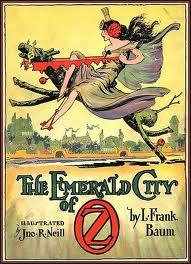Sunday, August 29, 2010
John Rea Neill
When I was about five years old my father and I ducked into a bookstore in NYC to avoid a pounding gale. Being that I was a relatively well-behaved child at the time, he permitted me to choose one book as a gift. Based on its spine, a bold yellow with thick black text, I extruded from a shelf The Wizard of Oz, by L. Frank Baum. I had not seen the Hollywood rendition of the story yet, and dubious as to my decision, a chapter book with less than a dozen pictures in it, my father suggested I peruse the book for a while, just to make absolutely certain I wanted it as my gift, that I wouldn't prefer a book with more images, seeing as I couldn't read yet, or even a book from the children's section, seeing as I was a child. After 20 minutes with the book, I remained certain of my decision, and so the book was bought, the story read to me on the many train rides taken on that trip to the North, and the tale's imagery cemented in my mind forever. My father ended up reading all of the Oz books to me, fourteen in total, along with Baum's American Fairytales, some time later.
The books and my personal history with them were not forgotten, but as I collect my own private library from my family's resources and from estate sales, I came across the series again, and have begun to examine them anew. Written for children, they are relatively quick reads, but the characters are magnificently well-imagined, and the dialogue dated yet humorous. But what is even more interesting to me as an adult artist, attempting to sharpen my discerning eye, are the illustrations. John R. Neill was commissioned to create accompanying images for the second Oz book, The Marvelous Land of Oz , in 1904, after Baum argued and lost contact with The Wizard of Oz's illustrator, W.W. Denslow. Since then, Neill's pen and ink Oz drawings have become what he is best known for, though he began his career in advertising.
The drawing style itself is very much of the era, with characters such as the famous Dorothy and other mortal humans, or normal animals in Oz being well-drawn but relatively innocuous, rendered in a style I associate with art nouveau. When it comes to the more whimsical personages in the story however, the overall stylistic aspects of Neill's mark-making give creatures such as cubic block animals, giant frogs, mangy lion-tiger-monkey hybrids, and my personal favorite, the patchwork girl, a very solid and enchanting quality.
Subscribe to:
Post Comments (Atom)









No comments:
Post a Comment